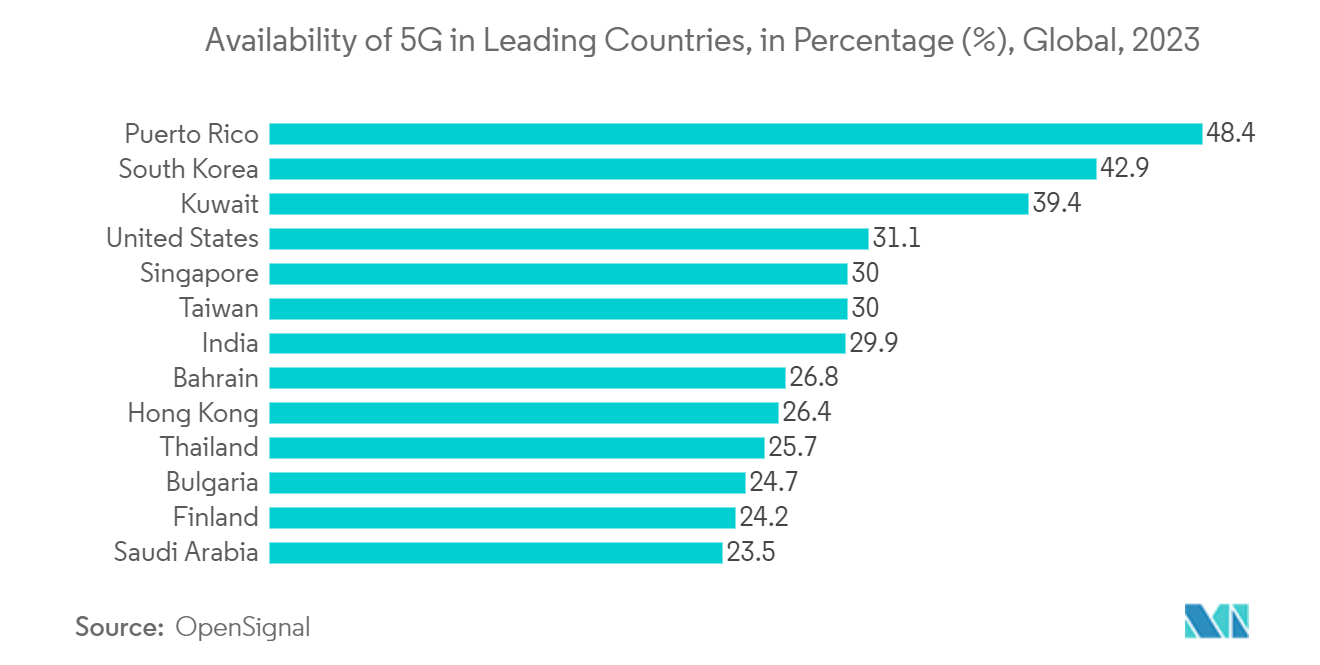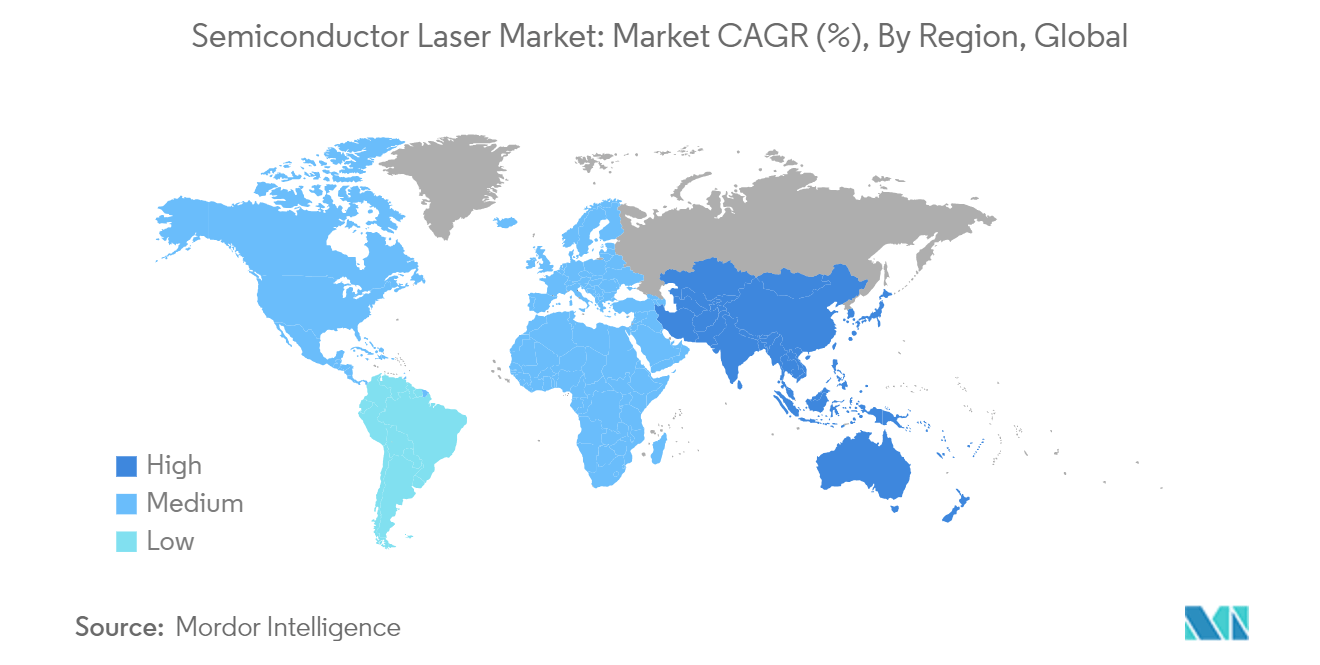Market Trends of Semiconductor Laser Industry
Communication Segment is Expected to Hold Significant Market Share
- Semiconductor lasers play a crucial role in modern communication systems, enabling high-speed data transmission over long distances with reliable performance. The communication industry dominates the global semiconductor laser market analysis categorized by applications, accounting for most of the global market. The global semiconductor laser industry has been primarily driven by the high applicability rate in optical communication. Laser diodes have evolved into an important component of broadband communication networks.
- Semiconductor lasers work as standard light transmitters in optical-fiber communication systems, owing to their small size of 0.2–1 mm length as well as their diverse excellent performances such as the capability of direct modulation up to 10–40 GHz, low-power consumption, single wavelength light, and high output power up to 1 W.
- Semiconductor lasers are a specific type of solid-state laser utilizing semiconductors as an active medium to amplify signals. Recently, fiber optics-based telecommunication networks have been the most preferred choice, with every optical link equipped with semiconductor lasers inside. Semiconductor lasers have served as the backbone for rapidly commercializing telecommunications and Datacom industries.
- Vertical-cavity surface-emitting Lasers (VCSELs) are the primary optical sources for optical links based on multimode fiber (MMF) in data centers and high-performance computers (HPCs). Recent designs in telecommunication systems aim to enhance VCSE semiconductor lasers to be more energy-efficient and capable of sustaining high modulation bit rates at room temperature without requiring adjustments to the operating parameters, even at elevated temperatures.
- Nanostructured Semiconductor lasers such as quantum dots have been highly preferred for optical telecommunication devices in recent times, as per the article published in IOP Conf. Series: Materials Science and Engineering, Quantum dot lasers play an important role in the telecommunication sector, especially in optical communication, driven by the demand for advanced technology and high optical gain.
- Moreover, in 5G and 6G telecommunication networks, swift and low-latency communications facilitate the interconnection of diverse endpoints. A common requirement in these critical applications is a laser source to execute intricate tasks at ultra-fast speeds, enabling broadband, secure, and energy-efficient communications. Countries are taking various initiatives to boost the deployment of 5G and 6G communication. According to OpenSignal, Puerto Rico led a 2023 ranking of 5G availability, with users of 5G handsets able to spend 48.4 percent of the surveyed period connected to a 5G service. Puerto Rico was followed by South Korea and Kuwait, with 5G availabilities of 42.9 and 39.4 percent, respectively.

Asia-Pacific Expected to Witness Major Growth
- The exponential growth in the communication industry in countries such as Japan, China, South Korea, and India is anticipated to drive the laser market in the Asia-Pacific region. Telecom network operators have installed fiber for all telecom applications, including inter-city, intra-city, FTTx, and mobile cellular systems. Apart from enterprises, the Chinese government authorities also install fiber systems to support the electric power grid, highways, railways, pipelines, airports, data centers, and many other applications, which drive the growth of the studied market.
- With the rapid development of AI, 5G, the Internet of Things, virtual reality, and the commercial application of these new technologies, the demand for data processing and information interaction is growing, which is expected to speed up the construction of data centers in the region and lead to the explosive growth of the industry.
- As internet traffic grows exponentially, reducing the energy consumption in data communications is crucial for sustainability. With their smaller size and lower energy consumption per bit, semiconductor lasers play a significant role in achieving energy efficiency in short-distance optical interconnects.
- Moreover, the flourishing electronics industry in this region and the increased production of consumer devices are accelerating the demand for semiconductor lasers as they are used for several manufacturing processes. Additionally, countries like China, Taiwan, Korea, and Japan are home to smartphone manufacturers such as Apple, Oneplus, Vivo, and Samsung, which makes semiconductor manufacturers around these regions produce semiconductor lasers that cater to the demands of these manufacturers.
- Also, favorable government initiatives and investments in Asia-Pacific promote the growth of the manufacturing sector and industrialization in the region, which drives the market’s growth. In February 2022, the government of India released a national strategy for additive manufacturing (or 3D printing) to encourage collaboration between academia, government, and industry to make India a global hub for the design, development, and deployment of 3D printing.
- China is one of the largest producers of semiconductors in the world, and the country is making steady investments in the industry as it has set a target to become fully self-sufficient in the semiconductor market by 2035. Similarly, Tokyo approved a JPY 774 billion (USD 4.93 billion) package for semiconductor investments in November 2021, including a JPY 400 billion (USD 2.55 billion) subsidy for Taiwan Semiconductor Manufacturing Company’s (TSMC) new foundry in Kumamoto prefecture. Such investments are creating a positive outlook for market growth.
- Datacenter traffic is rapidly increasing, owing to the rapid adoption of cloud applications, such as artificial intelligence, machine learning, augmented reality, and virtual reality, driving the market studied with innovations. According to Cloud Scene, some of the top markets in data centers include China, Japan, Australia, India, and Singapore. According to Clouscene, as of September 2023, there were 448 data centers in China, the most of any country or territory in the Asia-Pacific region. China had the fourth-highest number of data centers worldwide as of that month.


